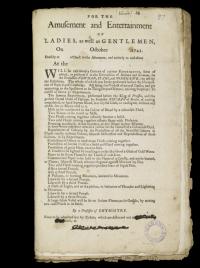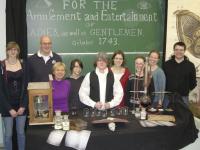Curious experiments: science, commerce and sectarianism in eighteenth-century Dublin
Published in 18th–19th - Century History, Issue 6 (Nov/Dec 2012), Volume 20, What’s new in manuscripts Today, the sole copy of the 1743 poster, poorly printed on cheap paper and about the size of a modern A3 page, survives in Marsh’s Library in Dublin. There is an unmistakable element of showmanship to the ‘curious Experiments’, and one can easily imagine Boyle Godfrey, or one of his associates, uttering the immortal lines ‘Roll up, roll up, roll up!’ when trying to attract paying customers to these afternoon shows.Godfrey’s claim that the experiments had been performed in universities in Holland and Germany, as well as in Oxford and Cambridge, was obviously intended to convince potential customers of their seriousness and propriety. Yet his descriptions of the procedures to be performed were also intended to be both eye-catching and sensational. Who could resist, for example, seeing ‘Two cold Fluids coming together [to] instantly flame with Violence’? Other intriguing descriptions include: ‘Two cold Fluids coming together [to] produce Stars of liquid Fire’; ‘a Vulcano, or burning Mountain, imitated in Miniature’; and ‘a Flash of Light, and an Explosion, in Imitation of Thunder and Lightning in Miniature’. There was also undoubtedly a consciously constructed frisson of danger involved in these experiments.In 1743 the impecunious Godfrey’s primary interest in these scientific demonstrations was undoubtedly commercial, but he did bring experimental science to audiences of men and women outside traditional sites of learning, and in doing so was at pains, in the words of the printed sheet, to show that all of the experiments were ‘the Product of natural Causes, and yet appearing to the Spectators to be Things beyond Nature’. One might say that Boyle Godfrey was packaging and selling the experimental method and world-view developed by the great figures of the Scientific Revolution to affluent consumers who wished to be educated, edified and entertained. As such, he is worthy of a place in modern histories of science, education and the development of consumer society.Yet Boyle Godfrey’s experiments also expose a virulent strain of religious sectarianism that runs contrary to modern notions of an eighteenth-century Enlightenment inspired by rationality, impartial knowledge and reasoned discourse. The first of the listed ‘curious Experiments’ had, it was claimed, been performed by ‘Professor Neuman of Berlin’ in front of the king of Prussia. It consisted of ‘causing coagulated, or hard human Blood, in a Crystal Glass, to run liquid, without any visible Arts or Means used to it’. Caspar Neumann was famous across Europe as the court apothecary to King Friedrich Wilhelm of Prussia. In March 1732, at the royal court in Berlin, Neumann ‘conducted for the first time the curious experiment of the imitation of the bloodflowing concerning the holy Januarius in Neapolis, about which all noble spectators were amused’. He seems to have repeated the experiment on a number of subsequent occasions in front of other distinguished gatherings of ‘the great and the good’.
Today, the sole copy of the 1743 poster, poorly printed on cheap paper and about the size of a modern A3 page, survives in Marsh’s Library in Dublin. There is an unmistakable element of showmanship to the ‘curious Experiments’, and one can easily imagine Boyle Godfrey, or one of his associates, uttering the immortal lines ‘Roll up, roll up, roll up!’ when trying to attract paying customers to these afternoon shows.Godfrey’s claim that the experiments had been performed in universities in Holland and Germany, as well as in Oxford and Cambridge, was obviously intended to convince potential customers of their seriousness and propriety. Yet his descriptions of the procedures to be performed were also intended to be both eye-catching and sensational. Who could resist, for example, seeing ‘Two cold Fluids coming together [to] instantly flame with Violence’? Other intriguing descriptions include: ‘Two cold Fluids coming together [to] produce Stars of liquid Fire’; ‘a Vulcano, or burning Mountain, imitated in Miniature’; and ‘a Flash of Light, and an Explosion, in Imitation of Thunder and Lightning in Miniature’. There was also undoubtedly a consciously constructed frisson of danger involved in these experiments.In 1743 the impecunious Godfrey’s primary interest in these scientific demonstrations was undoubtedly commercial, but he did bring experimental science to audiences of men and women outside traditional sites of learning, and in doing so was at pains, in the words of the printed sheet, to show that all of the experiments were ‘the Product of natural Causes, and yet appearing to the Spectators to be Things beyond Nature’. One might say that Boyle Godfrey was packaging and selling the experimental method and world-view developed by the great figures of the Scientific Revolution to affluent consumers who wished to be educated, edified and entertained. As such, he is worthy of a place in modern histories of science, education and the development of consumer society.Yet Boyle Godfrey’s experiments also expose a virulent strain of religious sectarianism that runs contrary to modern notions of an eighteenth-century Enlightenment inspired by rationality, impartial knowledge and reasoned discourse. The first of the listed ‘curious Experiments’ had, it was claimed, been performed by ‘Professor Neuman of Berlin’ in front of the king of Prussia. It consisted of ‘causing coagulated, or hard human Blood, in a Crystal Glass, to run liquid, without any visible Arts or Means used to it’. Caspar Neumann was famous across Europe as the court apothecary to King Friedrich Wilhelm of Prussia. In March 1732, at the royal court in Berlin, Neumann ‘conducted for the first time the curious experiment of the imitation of the bloodflowing concerning the holy Januarius in Neapolis, about which all noble spectators were amused’. He seems to have repeated the experiment on a number of subsequent occasions in front of other distinguished gatherings of ‘the great and the good’.

The author, Andreas Roth (second from left), and the students of Grashof Gymnasium, Essen, Germany, who recreated the experiments.
St Januarius is the patron saint of Naples, and every year since the late fourteenth century two vials of his coagulated blood have undergone a religious ritual which causes the blood to liquefy for a number of days. In the absence of a rigorous modern study of the vials, scientists have suggested that they may contain a solution of hydrated iron oxide, the viscosity of which increases if left unstirred and decreases if stirred or shaken. In February 1732, one month before Neumann recreated the miracle, Berlin had welcomed 10,000 Protestant refugees exiled from Salzburg in Catholic Austria. By reproducing this miracle in the Protestant milieu of the Prussian court at this particular time, Professor Neumann was poking fun at the perceived ignorance of the Catholic faithful and the mendacity of their priests and hierarchy. He was also explicitly linking Roman Catholicism with superstition and outdated ways of thinking, and suggesting that Protestantism allowed for new ways of thinking and engaging with the world.Neumann never divulged details of the chemicals he used to produce his parody of the blood miracle. Boyle Godfrey moved in very different circles to Neumann and is unlikely to have had access to Neumann’s secret. He must have deduced the most likely chemicals to have been used and then perfected the experiment through trial and error. There can be little doubt that Boyle Godfrey was aware of the sectarian context of Neumann’s experiment. While liquefying the ‘blood’ he is likely to have explained the context to anyone in the audience who was not already familiar with the mystery of St Januarius. To reproduce such an experiment in a city like Dublin in 1743 was to distinguish between two different types of ‘public’. One was superstitious, backward-looking and papist; the other was curious, open-minded, amenable to rationality and Protestant. The audience was surely invited to identify with this latter group. HI
A former teacher in Grashof Gymnasium, Essen, Germany, Andreas Roth now works for the German Foreign School Service in Belgrade.
For short films of the experiments search for ‘Curious Experiments 1743’ on YouTube.
















